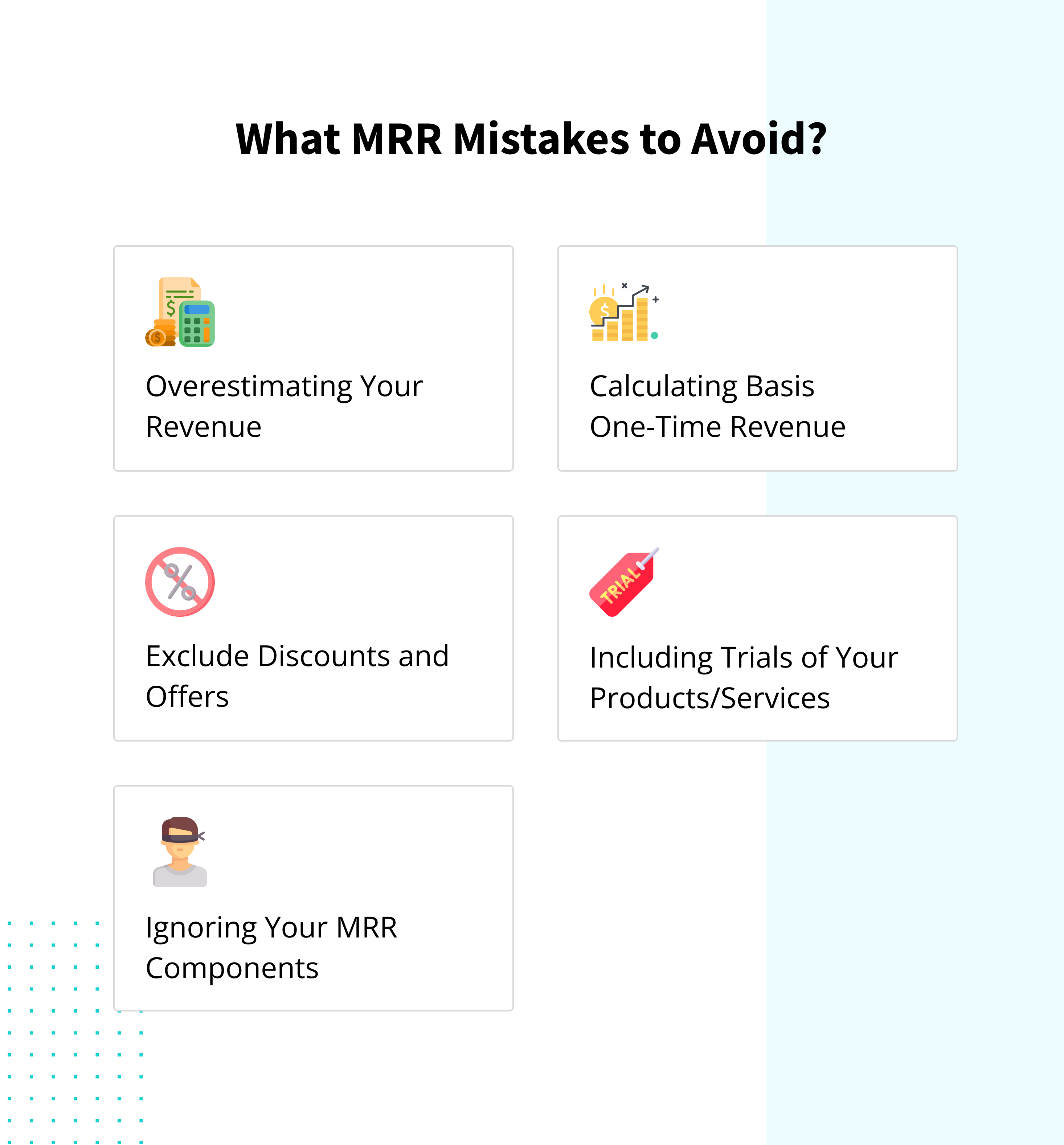Customers love a good product or service. As a business, if you are providing a value-adding service, chances are your customers will be loyal to your brand for time immemorial. Loyalty often translates into recurring monthly payments, ensuring a regular flow of income for your business.
But how do you calculate such monthly subscription revenue? There are separate metrics associated with recurring revenue, which are aptly captured within the concept of MRR.
MRR, or monthly recurring revenue, is a financial metric commonly used within the SaaS community.
In simple terms, MRR measures an organization’s monthly revenue. Essentially, it gives an overall picture of a company’s average monthly revenue using a subscription-based model. For example, if you have 20 customers who pay you $10 per month for your product, your MRR will be $200.
The average revenue per account is an important metric, mainly when calculating MRR. You can calculate this figure by dividing the total proceeds from all your customers by the total customers for the month. Nonetheless, MRR is an essential element when you must calculate the sale proceeds effectively.
When to Use MRR?
By way of MRR, you can gain some critical applications for your business. In the first go, you need to calculate the financial forecast for your business. A consistent MRR aids in the accurate predictability of the MRR to forecast the financial future.
If a company constantly achieves its targets, it becomes easier for the firm to model its future revenues. By way of an accurate MRR calculation, a business can accurately grow and forecast its trends and progress further through the years.
Good Read: Why Is the Subscription Model Gaining Popularity in India?
Types of MRR
MRR, as a financial metric, is quite complex and consists of many layers, which can prove crucial to a business. Due to their nature and complexity, there are a few MRR types that you should keep in mind always.
These are as follows:
-
New MRR
-
Upgrade MRR
-
Downgrade MRR
-
Expansion MRR
-
Churn MRR
-
Net new MRR
-
Contraction MRR
Let’s look at each of these in detail to understand each type better.
1. New MRR
New MRR, as the name suggests, is the MRR gained over a period from new customers. When calculating the MRR from all your customers, this metric will only look at the revenue from new customers.
For example, if you sign up ten new customers in July, each paying you $10, your new monthly MRR is $100. Similarly, all new customers you onboard during a specific month will contribute towards the calculations for new MRR.
2. Upgrade MRR
As a business, you would often continue to evolve in terms of your products and services. Better outcomes demand higher prices to stay competitive and meet the demand and supply of the market.
Upgrade MRR considers any additional revenue your business generates from subscriptions that move from existing pricing models to higher ones in a specific month.For example, if a customer who used to pay $50/month subscribes for a $150/month and subscribes to an add-on service of $25, then you can calculate Upgrade MRR in the following manner:
$150 – 50 +25 = $125
3. Downgrade MRR
Downgrade MRR works opposite to Upgrade MRR since it considers any reductions in the average revenue in a specific month. There are a few reasons which contribute to Downgrade MRR which are:
-
Existing customers moving from a higher plan to a lower subscription plan
-
Reduction in subscription quantity
-
Removing recurring subscriptions
4. Recurring discounts on products and services
Any of the above parameters can reduce your monthly revenue, leading to a decline in your MRR. To calculate downgrade MRR:
Downgrade MRR = MRR before the downgrade – MRR after the downgrade
For example, if 20 customers were paying you $20 each in the previous month but are now paying you $10 in the current month, it is a case of Downgrade MRR. The amount will be $200 instead of $400.
4. Expansion MRR
Contrary to New MRR, which talks about new customers, Expansion MRR deals with any subscriptions from your existing customers. When customers like your product suite, they will subscribe, take on more services, and add them to their existing portfolio.
This constitutes an expansion of the existing set of products and services, leading to an increase in the MRR. Some common contributors to Expansion MRR include add-ons, cross-selling, and up-selling.
A positive expansion MRR signifies customer satisfaction and loyalty, while a negative expansion MRR denotes a stagnancy in your existing customer portfolio.
To calculate the rate of growth, you can use the following:
Expansion MRR = (Expansion MRR in a month/Total MRR at the start of the month) * 100
5. Churn MRR
Churn MRR talks about the lost customer revenue who have canceled or downgraded their subscriptions. Assuming a customer cancels their $50 subscription and two others downgrade from $100 to $70, the total churn MRR would amount to $110.
6. Net New MRR
Now that all the other metrics are covered, it’s essential to calculate the gain or loss in revenue in the current month versus the previous month. A negative Net New MRR indicates lost revenue, while the opposite concludes gained revenue.
Here’s how you can calculate this metric:
Net New MRR= New MRR + Expansion MRR – Churned MRR
Suppose you have ten customers availing of a specific service, each paying you $100 monthly. Five customers have upgraded from one service to another, paying you $200 instead of $100/month. During this period, three customers churned out as well.
Your Net New MRR is 1000 + 500 - 300 = $1200
7. Contraction MRR
As the name suggests, contraction MRR mentions any loss in subscriptions during a given month. These include cancellations, downgrades of existing customers, paused subscriptions, discounts, or stopped recurring add-ons.
If you give ten loyal customers special discounts of $30 during the festive season, your contraction MRR will be $300.
Look at : https://inai.io/subscription-management to understand how you can manage and optimize your subscriptions with Inai.
How to Calculate Monthly Subscription Revenue?
There are a few ways to calculate your monthly subscription revenue, which include the following:
-
Customer Churn Rate (CCR)
-
Average Revenue Per Account (ARPA)
-
Customer Lifetime Value (CLV)
Here’s what you need to know about each of these three methods:
1. Customer Churn Rate (CCR)
To calculate your customer churn rate, you need to combine all your monthly recurring revenues (MRR) at the start of the month and divide it by the loss in monthly recurring revenue during the month – any additional upgrades/revenue during the same month. You need to exclude any new monthly sales.
If your company had 500 customers at the beginning of June, only 450 customers were present towards the end of the month. Your customer churn rate would be 10%.
500-450/500 = 10%
2. Average Revenue Per Account (ARPA)
Average Revenue Per Account (ARPA), commonly known as average revenue per unit, is widely used by digital media and social media companies to assess their income at a customer level.
You can calculate average revenue per account with the following formula:
ARPA = Total Revenue/average subscribers
This metric is quite helpful when dealing with account expansions and contractions to evaluate pricing plans and drive the ARPA evolution.
3. Customer Lifetime Value (CLV)
The final method is the Customer Lifetime Value (CLV), which measures a business’s expected total income from a customer during their lifetime. To calculate the CLV, you need to look at the total average revenue from a customer and the total average profit.
CLV = Average Transaction Size * Number of Transactions * Retention Period
Let’s take an example; say a media streaming company offers its basic subscription plan to a customer for $17. Customers usually subscribe to such services for three years (on average) via automated monthly payments.
CLV = $17 (average sale) * 12 (annual purchases) * 3 (years) = $612
What MRR Mistakes to Avoid?

As a business, you need to calculate your MRR accurately to forecast your monthly subscription revenues. However, you must avoid a few misleading mistakes while performing these calculations to ensure you get the correct monthly figures.
Here are some top mistakes to avoid while calculating your MRR:
- Overestimating Your Revenue
When calculating your monthly revenues, you need to consider the relevant figures rather than inflate your income. Avoid using semi-annual or annual revenues during such calculations, especially when a new customer subscribes to your product/service.
Instead, divide the total revenue from a customer by 12 to ensure you have the correct monthly figure at the time of calculations.
2. Calculating Basis One-Time RevenueThe essence of MRR is recurring income, not individual payments. One-time transactions will positively impact your bottom line, but they can’t be used actively while calculating MRR figures.
Since these are one-time payments, they can overstate your total revenues and forecasts, affecting your payment model.
3. Exclude Discounts and Offers
While calculating MRR, you should consider any discounts and special offers you might have rolled out to your customers. As a practice, you can’t include the full price since that will inflate your total income.
For example, when you are offering a discount of $100 on a product costing $200/month, your MRR will be $100. It’s essential to reduce the discount from the original price of the product/service.
4. Including Trials of Your Products/ServicesWhen a customer enrolls for a trial version of your product/service, you can’t bank upon this income source and include it within your MRR calculations.
While a specific part of your trials will convert and become a regular source of subscription revenue, you can’t be sure until you have the final confirmation.
- Ignoring Your MRR Components
MRR consists of various components, and each plays an integral role in MRR calculations. If you disregard any of these elements, you might overlook the red flags, such as high churns, which might get masked with high growth.
How Can inai Help?
inai is a payment aggregator solution that offers you complete subscription management software using which you can scale your business globally. Along with setting up subscriptions the traditional way, inai can help you connect crypto payment gateways (Xanpool, Transfi) with different payment processors for accepting and processing cryptocurrencies for subscription payments across multiple geographies.
inai can also help you with payouts. Once the payment is received, we can help you make fiat payouts, i.e., payouts in regular currencies across different geographies. And during transfers, we connect you with the cheapest payment rail to save you money. In addition, a single front-end adapts to different fields as payment methods change, making it easy to integrate.
.png?width=123&height=71&name=inai%20logo%20-%20dark%201(1).png)

%20(1).png?width=941&height=250&name=CTA%20(9)%20(1).png)


.jpg?width=50&name=IMG_5672%20(1).jpg)


